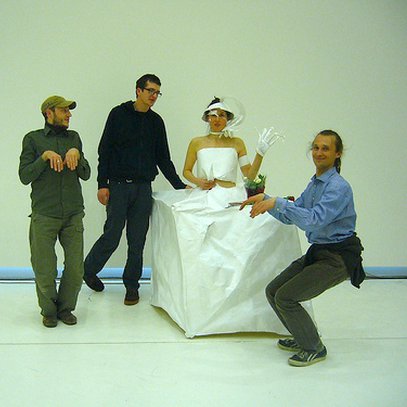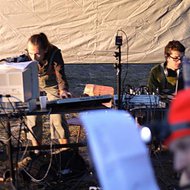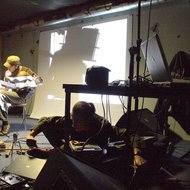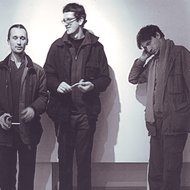Betoniniai Triušiai
Betoniniai Triušiai (The Concrete Bunnies) is a group of three musicians, surfing the waters of the avant-garde and free diving into them. This, however, is only one side of the story; Betoniniai Triušiai challenge the notion of avant-garde too by using sounds to mold an autonomous alloy of different expressions. In an attempt to pinpoint particular features one may notice that: a) a phantasm of ambient coruscates somewhere in the backdrop; b) the occasional lo-fi (low fidelity) passages are not something the authors shy away from, and c) the character of their soundscape is largely influenced by the urban folk and sound poetry aesthetics. In fact, poetry is an inseparable part of their sonic language. They don’t evade semantics or semiotics, except all of that gets lost in a void when coated with reverb, uttered in an aggressive tone or defragmented to become nothing but a kind of a ‘personal jargon’. Sounds too get similar treatment and together with poesy form outlandish, swaying soundmasses that hang in the air like a hiss. Amidst all of that the authors manage to leave space for some playful improvisation. Their live music is intense and impulsive, often composed with the aid of some non-musical objects. By doing so, the authors create a true performance and add yet another vector to their space-time continuum.
Povilas Vaitkevičius
sisyphus (from CD III)
deadlands (from CD III)
Marvele Hill (from CD God-thing)
Big Red (from CD God-thing)
God-Thing (from CD God-thing)
Marakana People Macaroni Land (The Hymn) (from CD I)
The Night of Red Corpuscules (The Verse) (from CD I)
The Nutcracker (...) (from CD I)
Biography
Betoniniai Triušiai (The Concrete Bunnies) is a group of three musicians, surfing the waters of the avant-garde and free diving into them. This, however, is only one side of the story; Betoniniai Triušiai challenge the notion of avant-garde too by using sounds to mold an autonomous alloy of different expressions. In an attempt to pinpoint particular features one may notice that: a) a phantasm of ambient coruscates somewhere in the backdrop; b) the occasional lo-fi (low fidelity) passages are not something the authors shy away from, and c) the character of their soundscape is largely influenced by the urban folk and sound poetry aesthetics. In fact, poetry is an inseparable part of their sonic language. They don’t evade semantics or semiotics, except all of that gets lost in a void when coated with reverb, uttered in an aggressive tone or defragmented to become nothing but a kind of a ‘personal jargon’. Sounds too get similar treatment and together with poesy form outlandish, swaying soundmasses that hang in the air like a hiss. Amidst all of that the authors manage to leave space for some playful improvisation. Their live music is intense and impulsive, often composed with the aid of some non-musical objects. By doing so, the authors create a true performance and add yet another vector to their space-time continuum.
According to its members, the sound and poetry group Betoniniai Triušiai was born in Vilnius during the winter of 2005. The membership hasn’t changed since then, which perhaps is essential to the existence of this project, for the ‘musical function’ within the band is largely determined by each individual’s personality. Antanas Dombrovskij is the chief soundscape achitect, whose music expertise is ever-growing through his involvement in multiple projects. His seeks more intimate audio-adventures under the pseudonym of Gana2, while his collaborative work includes the ‘laptop quartet’ Twentytwentyone and a duet called Tiese (Straight line) with Vilius Šiaulys.
Within the Lithuanian cultural domain Tomas S. Butkus is known as a poet, publisher and graphic designer. In 1992 he started a ‘concept workshop’ Vario Burnos (Copper Mouths) which was in charge of many book formats and many Betoniniai Triušiai releases. T. S. Butkus is the one and only author of texts, whose postmodern irony and wordplay have become an inseparable component of the band’s aesthetic. Last but not least, Vadimas Korotajevas – a free-spirited artist, whose unpredictably extravagant insertions add an extra edge to the live performances and the recordings of the Betoniniai Triušiai.
Back in 2005 the newly established band was rehearsing in the basement of the no-longer existing club Virpesys. It was also when their first musical alloys were being created and soon were being showcased at some occasional live performances. The first one took place in Jurbarkas in August 2006. Other significant events followed, including an audiovisual poetry festival TARP and Literatūros Salos (The Literature Isles) in Kėdainiai. In 2007 Betoniniai Triušiai presented their first large-scale work – an opera Marakana, which was going to be presented at the ruins of the Millenium Stadium at one of the Vilnius - European Capital of Culture 2009 happenings. Due to the construction works at the original venue the action was transplanted to the former Dinamo stadium. This event resulted in a first, oficially titleless but known to the public as the ‘grey album’. It was released in 2008 by two labels, the T. S. Butkus’ Vario Burnos and Kitos Knygos (Other Books). The lyrics featured cunning ironies, verbal delirium and some psychodelic-esque didacticism. The names of the characters speak for themselves: Jaunieji Marakonieriai, Triušiai Draugovininkai, Ozono Kalva, etc.
Many concerts followed, both in Lithuania, including the aforementioned TARP festival, and abroad. The second album is a chronicle of this period. It was co-released by Vario Burnos and the bookstore Eureka!. The album called Dievas-Daiktas (Eng.: God-Thing) was released in 2010 in a book-shaped package. It is a collection of live recordings from the concerts in Berlin, Vilnius, Kėdainiai, Pilis I Village and Plungė. The number of sources the recordings came from had no impact on the continuity of sound. A few guest artists joined in on some tracks – Raminta Kurlietytė (saxophone), Lina Lapelytė (violin) and Luis Javier Londoño (percussion).
After a three-year-long hiatus, in 2012 the band released its third album. This time it was not a compilation of live performances, and it demarcated a different phase in the group’s career. The album was titled rather laconically – III. Their usual soundscape was complemented with the equally laconic soprano passages by Skaidra Jančaitė. The album was released by Vario burnos in a book-shaped packaging (which became a customary practice for the band). The tracks feature lyrics by Tomas S. Butkus as well as Mantas ‘Šamanas’ Gimžauskas (RIP).
Although Betoniniai Triušiai has been a little less active recently, their pointy ‘bunny ears’ can be spotted every now and then amongst the misty hiss of audio-poetry. The band sometimes performs at more isolated events and remains ‘faithful’, if you will, to its mission of challenging the conventional sound-structures and creating unexpected compositional turns.
Povilas Vaitkevičius
+370 687 39512



